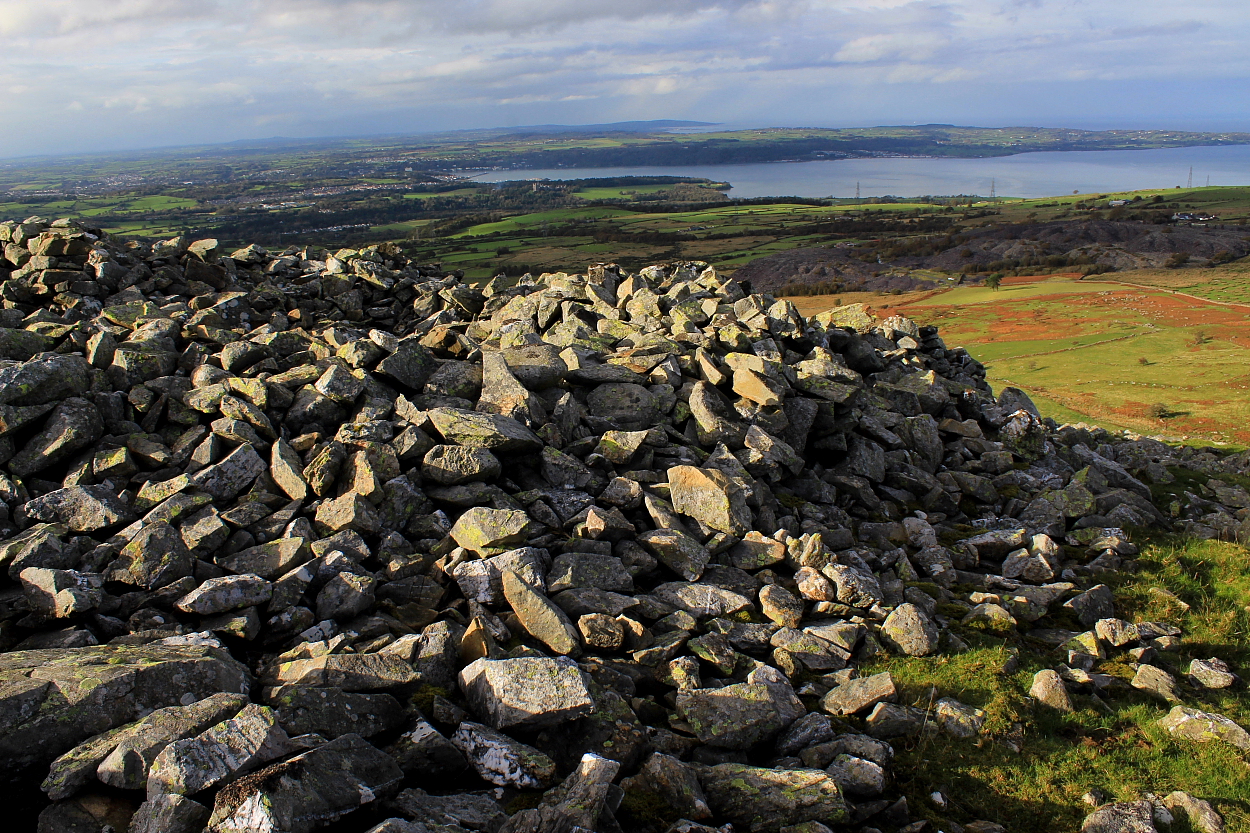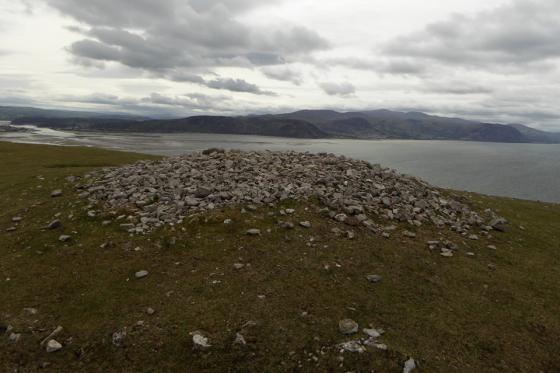
Moel Wnion, Gyrn and Drosgl form the skyline (left to right)

Moel Wnion, Gyrn and Drosgl form the skyline (left to right)

Northern cairn, looking across to a cloud-wreathed Carnedd Dafydd...

Middle cairn......


The central cairn of the recognised trio

The southernmost cairn, apparently of modern origin.... although not obviously so, when compared to some I’ve seen. However, judging by the copious local traffic Moel Faban received during the hours I was here (dog walkers, poorly dressed old men etc) the likelihood for a new cairn to have been erected in historic times is clearly pretty high. Carnedd Dafydd rises beyond.

Looking toward Anglesey and The Menai Strait

Looking across Bwlch ym Mhwll-le from the great northern cairn. Note the great cairn overlooking the other flank of the pass, centre right, with yet another monster crowning Moel Wnion, centre background. The pyramidical Gyrn (top right) curiously looks much taller than the Moel Wnion from here...

The modern marker cairn at the southern end of the summit ridge boasts terrific views of the Ogwen Valley. I can’t find anything to indicate that it is built from anything older, but there’s so much going on up here that I wouldn’t discount it either.

The southern cairn, looking SE towards Yr Elen and Carnedd Dafydd.

The less-knackered central cairn, looking north. The shoulder of Moel Wnion fills the right of the picture.

The knackered northern cairn, looking across to Ynys Mon.

Moel Faban from Tan-y-Garth above Bethesda.

Three cairns on Moel Faban (with walkers), the left most is a walkers cairn, out of view is the third actual cairn.

Alken leads the way to Moel Faban and a couple of surprise cairns.

Three large ancient cairns adorn the hill top

Hiding from the stingy face sideways rain. The big hill is Drosgl.

From the cairn on the edge of the hill, looking back up to the central cairn.

The central cairn, looking over to Moel Wnion on the left and Drosgl on the right

The south west cairn

The south west cairn and the central cairn beyond

Looking from the great Drosgl cairn.........

moel Faban in Pyramidal form

The much mutilated but still substantial fourth cairn.

Cairn 3 and 2 from cairn 4

Cairn 3 and 2 in the background

Cairns 2 and 3, with Gyrn and Moel wnion beyond

This is the first cairn arrived at on Moel Faban, I am unsure as to it’s antiquity, but am sure of it’s view down the Ogwen valley being tremendous.

The cairns are clearly visible in this close up of Moel Faban’s summit ridge.

The site from Gyrn Wigau......... centre right, just caressed by the early morning sun.
Faban – u – lous!
It’s a steep climb for tired legs up onto the Moel Faban summit ridge, and the horizontal rain chooses this point to restart its assault. Gladman may wish to look away now, but we take shelter in the hollowed-out centre of the northern of the summit’s sizeable cairns. This one reminds me very much of some of the big examples on the western tops of Y Mynydd Ddu in South Wales.
The rain relents a little, to the north the blue skies pretending it’s still a lovely day. We emerge from hiding and carry on along the ridge. All the cairns here are magnificent, and the views from this relatively modest hill are superb. A fine example of how a look at the map is no substitute at all for a visit. And a great finish to the day with plenty left to come back for another time.
From where I parked the car near Pen y Gaer the small mountain takes on a pyramidal shape, a footpath leads from the road straight up to the top, but seeing as I went to the hillfort first I had to climb a couple of fences untill the path and me crossed paths. On the way up I followed a samll stream thin enough to step over, but big enough to be teaming with fish at least 6inches long, species unknown, salmon or trout probably.
Half way up the slope I came across a circle of stones, not a stone circle and too small for a hut circle or shelter. Strange.
As I neared the top the weather did what it does best, it didnt rain, oh no, that would be too heavy handed, the clouds came in and the views that I so love faded away, mountains are like that, they want to be appreciated they want to be adored but they don’t want it to be easy for you, they only rarely show themselves completely
like a shy yet demanding stripper.
The first cairn arrived at didnt look ancient but more like a walkers cairn to show that your at the top, but it has the best view down the Ogwen valley.
The second cairn is the real McCoy, it almost shuns the view back into the mountains and concentrates on gazing out to sea or perhaps more probable onto Anglesey, always the most special of megalithic locations in Wales.
The cairn has been converted into a walkers shelter, I dont know if this is proper, but, I started to try and make it look more like a cairn again, just a half hearted attempt for half an hour, the spirits may have looked kindly upon me as I swear the cloud looked to be thinning and the sky had a more blue colour.
The second big cairn has also been shelterized so I gave it another half hour reconstruction, not so anyone would notice, but atleast there were no more precariously placed boulders threatening to fall on an unconcerned shelterer.
By the time I reached the last cairn in the line the mist was really dispersing, and I felt my endeavours at reconstruction were appreciated.
This cairn is the biggest one here, so big that it contains three walkers shelters, and one breakaway shin high shelter. The bigger hills come into view out of the mist Gyrn to the north-east and behind that Moel Wnion, but Gyrn Wigau and Drosgl remain stubbornly hidden.
I only gave the shelters a cursory pushing in and as I sat down to appreciate the views opening before me a final large rock fell just 10 inches onto my little finger, it didnt break but it was a right mess, luckily my extremities were freezing so it didnt bleed much. Time to start back, by that I mean another walk along the ridge this time in sunshine and then down the slope to the other cairns and the fortified settlement above Rachub.
It was still a small price to pay for the clouds to part for me and the mountains show themselves to me.
Gladman was right, they are worthy of a visit in the own right, and then some.
The question as to whether the burial cairns had been used for ‘walker cairns’, or other purposes remain unanswered. But the following information does state that one of the cairns was excavated in the 19th century. It is also interesting about the extensive settlement pattern below the summit cairns.....
“Carneddau Estate – Moel Faban,
prehistoric houses, paddocks and fields;
The rounded hump of Moel Faban (“moel” in Welsh means bare or bald hill in this context)
dominates the village of Bethesda and on both its east and west sides is extensive evidence of prehistoric settlement.
The east side was surveyed by RCAHM (Wales) for part one of the Caernarfonshire Inventory published in the 1950s but further evidence of prehistoric land use has become more apparent recently, and a new survey as part of a more long-term and comprehensive survey of the hill was commissioned.
The summit has a series of Bronze Age cairns, one of which was excavated in the nineteenth-century from which a collared urn of the middle Bronze Age was removed (now in the British Museum).There is no clear relationship at all but it is thought that some of the dwellings within the field-system could also have Bronze Age origins, but by analogy with similar sites they would normally be thought later. None has been excavated so this earlier date has by no means been confirmed. As well as concrete evidence of cultivation, or at least controlled pasturage, this immediate area has other tantalising evidence of prehistoric life.
This includes Bezant Lowe called the “arrow stone”, a massive boulder on the top of which is extensive evidence of the sharpening of blades. There is to the east of the hill fairly conclusive evidence of burnt mounds situated by the stream of the Ffryddlas where food was cooked by dropping heated stones into small constructed pools, a technique that has been proved to work, as anyone watching “Time Team” will know!”
The ‘Arrow Stone’ on Rockartuk
rockartuk.fotopic.net/c1224904.html
References:
RCAHM(W) 1956 Carnarvonshire vol 1
Bezant Lowe,W. 1927 In the Heart of Northern Wales pp53 – 56
Griffiths,W.E.1959 Arch. Camb 101, pp44
Quite apparent when viewed from Gyrn Wigau on the ascent to Drosgl from Bethesda, this grouping of cairns, crowning the minor, outlying summit of Moel Faban, appear well worth a special visit in their own right. One for ‘the list’. There are also numerous prehistoric settlements in the vicinity.
According to Coflein:
‘Extensive ridge-top cemetery of cairns, running for some 300m, aligned north-east to south-west with the ridge. Part of wider cemetery which extends to the west’.
































































































































































































